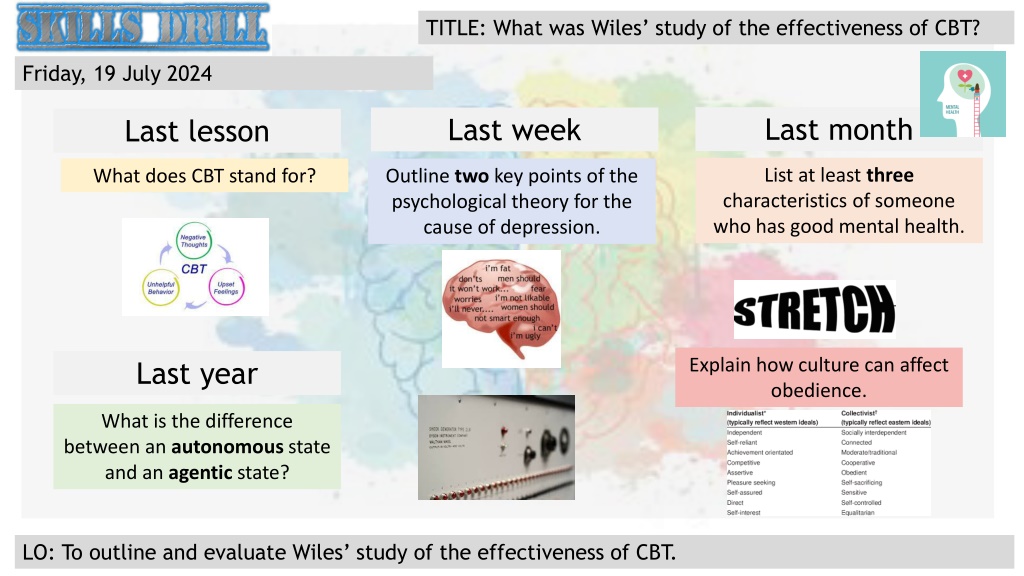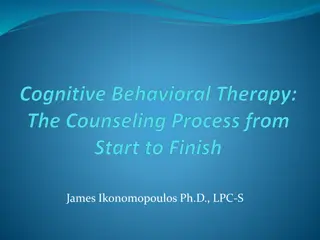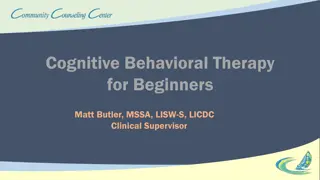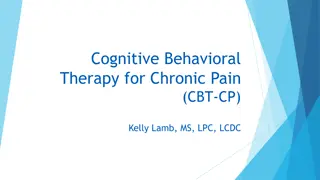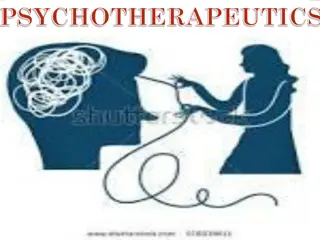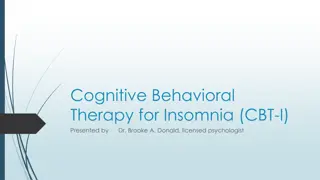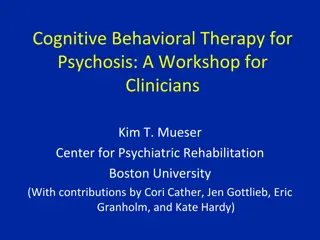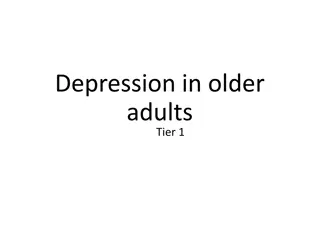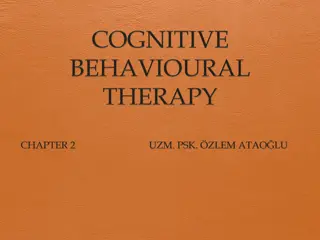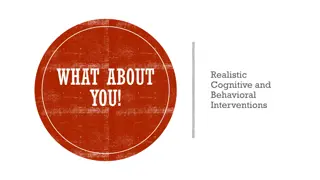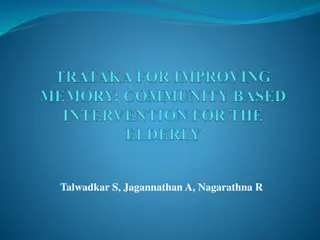Evaluating the Effectiveness of Cognitive Behavioral Therapy (CBT) in Treating Depression
Wiles' study on the effectiveness of CBT in treating depression highlighted key strengths and weaknesses of the therapy. The study showed that CBT can provide lasting effectiveness by teaching clients skills to manage future episodes of depression. However, it also pointed out that CBT requires significant time and effort, leading to engagement challenges for some individuals. Furthermore, the holistic approach of CBT, focusing on the core symptoms of depression, was seen as a valuable aspect of the therapy. The research design was carefully structured to control extraneous variables, ensuring the reliability of the results.
Download Presentation

Please find below an Image/Link to download the presentation.
The content on the website is provided AS IS for your information and personal use only. It may not be sold, licensed, or shared on other websites without obtaining consent from the author. Download presentation by click this link. If you encounter any issues during the download, it is possible that the publisher has removed the file from their server.
E N D
Presentation Transcript
TITLE: What was Wiles study of the effectiveness of CBT? Friday, 19 July 2024 Last month Last week Last lesson List at least three characteristics of someone who has good mental health. What does CBT stand for? Outline two key points of the psychological theory for the cause of depression. Explain how culture can affect obedience. Last year What is the difference between an autonomous state and an agentic state? LO: To outline and evaluate Wiles study of the effectiveness of CBT.
Making sense of CBT LO: To outline and evaluate Wiles study of the effectiveness of CBT.
RECAP What were some of the evaluation points that we discussed last lesson about CBT? LO: To outline and evaluate Wiles study of the effectiveness of CBT.
Evaluating CBT Lasting effectiveness One strength of using CBT to treat depression is that it has lasting effectiveness.The tools learned in CBT to help challenge irrational thoughts can help the client deal with future episodes of depression. Therefore, this therapy offers a long-term solution where the client can draw on the skills they learned in the future. It s not for everyone One weakness is that it takes a lot of time and thought for CBT to be successful. Therapy takes months, homework is expected so a lot of effort is needed in comparison to just taking a pill. This means that many people drop out or fail to engage enough for it to work. Holistic approach Another strength of CBT is that it is holistic. CBT focuses on treating the whole person and what they think/feel. This may be preferable because it deals with the core symptoms of depression (e.g. feeling sad). LO: To outline and evaluate Wiles study of the effectiveness of CBT.
What did Wiles do? Cut out the key AO1 parts of Wiles study and stick them into the relevant sections in your booklets. 5 mins! LO: To outline and evaluate Wiles study of the effectiveness of CBT.
Evaluating Wiles study For each of the evaluation points write notes in your booklets. Well designed study P One strength of this study is that is was very carefully designed to control EVs. E One potential EV was participant differences. It could be that the patients in the usual care group happened to be more depressed than the CBT group. To ensure this didn t happen, participants were randomly assigned to groups. BDI scores were also checked and were similar at the beginning of treatment. E This means that we can conclude with confidence that the DV (reduction of symptoms) were not affected by this EV. LO: To outline and evaluate Wiles study of the effectiveness of CBT.
Evaluating Wiles study For each of the evaluation points write notes in your booklets. Assessment of depression P One weakness is the use of self-report methods to determine levels of depression. E The use of self-report means that participants have to make subjective judgements and may not answer statements truthfully. Some people might underestimate how sad they feel and others may overestimate. E This questions the validity of the information collected about depression. LO: To outline and evaluate Wiles study of the effectiveness of CBT.
Evaluating Wiles study For each of the evaluation points write notes in your booklets. Real world application P One strength of this study is that it is focused on developing a useful therapy. E The main aim of the research was to demonstrate that a more holistic approach to treating depression can be successful more successful than anti- depressant medication alone. Moreover, the therapy was relatively cheap ( 343 per year) which is the equivalent cost of some medication. E Such real-world usefulness is one of the main reasons for conducting research and as such this study helps us to further understand effective treatments for depression. LO: To outline and evaluate Wiles study of the effectiveness of CBT.
Complete these tasks. 1 2 In your booklet. Handout. Glue in and complete in books. LO: To outline and evaluate Wiles study of the effectiveness of CBT.
Q1. In Wiles study, participants were randomly assigned by: a. Names drawn from a hat b. Computer-generated code c. Picking names from a list d. Participants volunteering. LO: To outline and evaluate Wiles study of the effectiveness of CBT.
Q1. In Wiles study, participants were randomly assigned by: a. Names drawn from a hat b. Computer-generated code c. Picking names from a list d. Participants volunteering. LO: To outline and evaluate Wiles study of the effectiveness of CBT.
Q2. For the CBT + medication group there was a more than 50% reduction in symptoms: a. In 21.6% of patients b. In 46.1% of patients c. In 50.3% of patients d. In 70.6% of patients. LO: To outline and evaluate Wiles study of the effectiveness of CBT.
Q2. For the CBT + medication group there was a more than 50% reduction in symptoms: a. In 21.6% of patients b. In 46.1% of patients c. In 50.3% of patients d. In 70.6% of patients. LO: To outline and evaluate Wiles study of the effectiveness of CBT.
Q3. Symptoms were assessed after: a. 6 months b. 1 month and 6 months c. 6 months and 12 months d. 6 months and 2 years. LO: To outline and evaluate Wiles study of the effectiveness of CBT.
Q3. Symptoms were assessed after: a. 6 months b. 1 month and 6 months c. 6 months and 12 months d. 6 months and 2 years. LO: To outline and evaluate Wiles study of the effectiveness of CBT.
Q4. A person may be seen to have a mental health problem if they: a. Cannot cope with life b. Have no friends c. Are different from others d. Feel unhappy. LO: To outline and evaluate Wiles study of the effectiveness of CBT.
Q4. A person may be seen to have a mental health problem if they: a. Cannot cope with life b. Have no friends c. Are different from others d. Feel unhappy. LO: To outline and evaluate Wiles study of the effectiveness of CBT.
Q5. Tables and graphs are: a. Averages b. Descriptive statistics c. The spread of data d. Measures of dispersion. LO: To outline and evaluate Wiles study of the effectiveness of CBT.
Q5. Tables and graphs are: a. Averages b. Descriptive statistics c. The spread of data d. Measures of dispersion. LO: To outline and evaluate Wiles study of the effectiveness of CBT.
